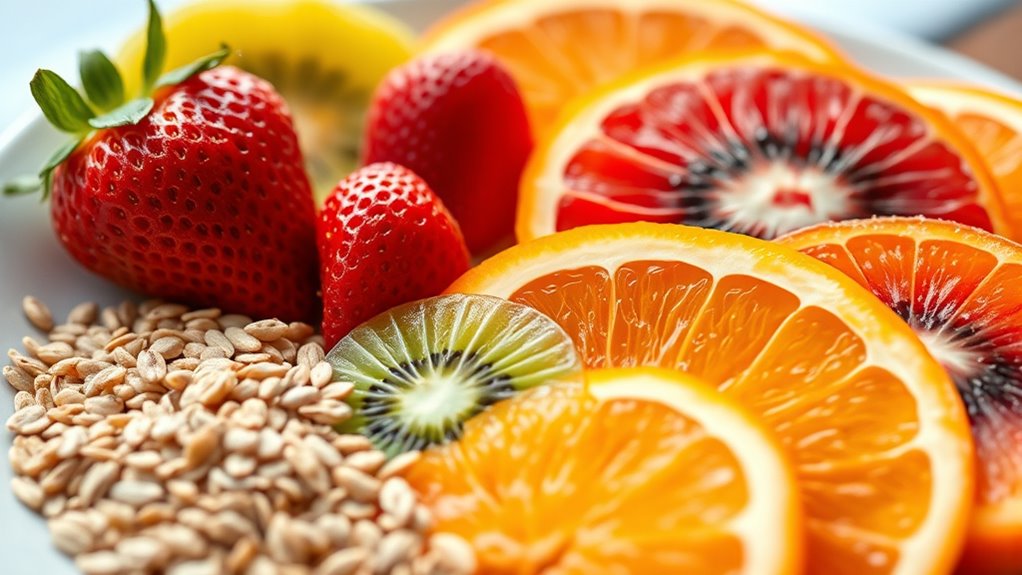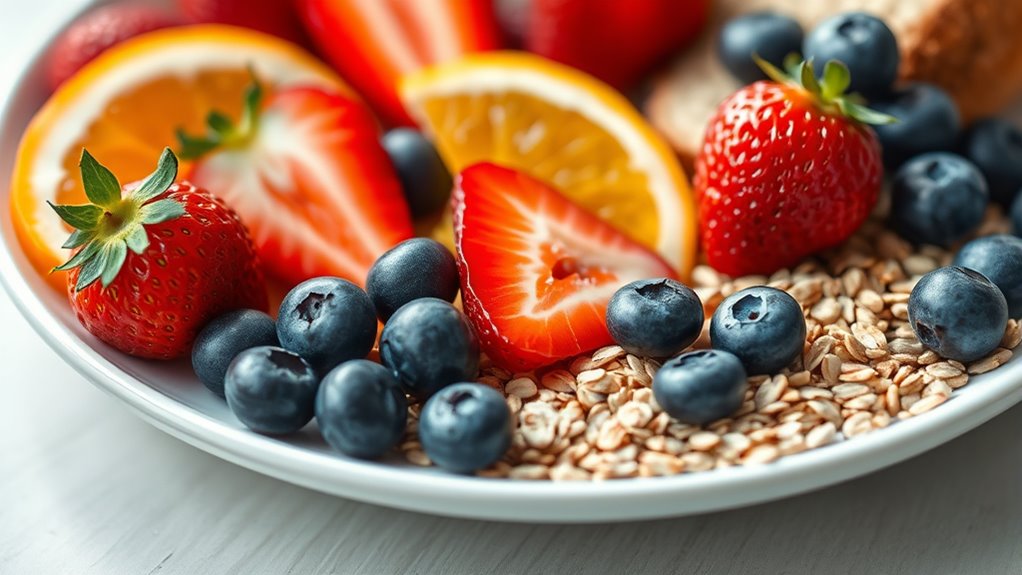Food combining myths suggesting you must separate fruit from grains have no scientific backing. Your digestive system is designed to handle mixed foods efficiently, activating enzymes in your mouth, stomach, and intestines to process various nutrients at once. These beliefs stem from outdated ideas rather than facts, so there’s no need to worry about pairing fruit with grains. To discover more about how digestion really works and what benefits these myths may have, explore further insights below.
Key Takeaways
- Scientific evidence shows no need to separate fruit from grains for proper digestion.
- The digestive system processes mixed foods efficiently with enzymes targeting various nutrients.
- Food combining myths are based on outdated theories, not supported by modern nutritional science.
- Combining fruit and grains does not cause indigestion or nutrient absorption issues.
- For balanced nutrition, focus on diverse, wholesome foods rather than strict food separation rules.
The Origins of Food-Combining Beliefs

The origins of food-combining beliefs are rooted in ancient dietary theories that sought to improve digestion and health. These ideas stem from historical misconceptions about how the body processes different foods. Many early cultures believed that mixing certain foods could cause indigestion or toxins, leading to strict rules about what to eat together. Cultural influences played a big role, as societies developed their own dietary practices based on limited scientific knowledge. These beliefs were often passed down through generations, shaping dietary habits even today. Over time, people accepted these rules without questioning their validity, believing they promoted better health. While these ideas seemed logical at the time, modern science shows that many of these misconceptions aren’t supported by evidence. Additionally, understanding the role of contrast ratio in visual clarity can be likened to how the body’s digestion may respond differently to various food combinations, although current research suggests that such distinctions are less significant than once thought. Recognizing the historical context of these ideas helps in understanding why such food rules persisted for so long despite a lack of scientific validation.
How Digestion Actually Works

Understanding how digestion actually works can clear up many misconceptions about food combining. When you eat, your body activates enzymes tailored to break down different foods, and your gut microbiome plays a crucial role in this process. Digestion involves several steps:
- Enzyme activation begins in your mouth and continues in your stomach and intestines, targeting specific nutrients.
- Your gut microbiome helps ferment and process fibers and complex carbs, supporting overall digestion.
- Nutrients are absorbed through the intestinal walls, regardless of food type, with minimal interference from food combinations.
- Modern sound design techniques, such as layering multiple audio elements, can be applied to enhance informational content, making explanations more engaging and accessible.
- The diversity of dietary components processed simultaneously highlights how adaptable and resilient your digestive system truly is.
Instead of strict rules, your body adapts by efficiently breaking down various foods simultaneously, thanks to enzyme versatility and a healthy microbiome. This dynamic process ensures proper nutrient absorption without the need for rigid food separation.
Separating Fruit and Grains: Is There Any Scientific Basis?

Many claim that eating fruit and grains together hampers digestion, but scientific evidence doesn’t support this idea. This myth busting shows that there’s no solid digestion fact proving you need to separate them. Your digestive system is designed to handle a variety of foods simultaneously, breaking down carbohydrates, fiber, and sugars efficiently. Studies have shown that combining fruit and grains doesn’t cause indigestion or nutrient absorption issues. Instead, your body adapts to digest mixed meals without trouble. The belief that fruit and grains should be separated lacks scientific backing and is more rooted in food combining myths than in actual digestion facts. So, you can enjoy these foods together without worrying about hindering your digestion process.
Potential Benefits and Drawbacks of Food Combining

Food combining enthusiasts often claim that eating certain foods together can enhance digestion and boost nutrient absorption, but these potential benefits aren’t consistently supported by scientific evidence. Myth debunking shows that many digestion misconceptions stem from outdated ideas, not science. While some people report feeling better on food-combining plans, these effects may be placebo or related to overall healthier eating habits. Potential benefits include:
- Simplified meal choices that may reduce digestive discomfort for some individuals
- Increased awareness of food types and portion sizes
- Encouragement to eat more mindfully and avoid processed foods
- Pregnancy and other health factors can influence how your body digests different foods, highlighting the importance of listening to your body’s needs.
Research indicates that your body’s digestion is more adaptable than some food combining myths imply, emphasizing the importance of a balanced and varied diet. Additionally, AI security technologies are being developed to better understand complex biological processes, which could ultimately improve dietary recommendations. Moreover, understanding digestive processes helps clarify that meal timing and overall food quality often play a more significant role than strict food separation. However, nutrient absorption can sometimes be affected by meal composition, especially if restrictions limit certain food groups.
Practical Advice for a Balanced Diet

Achieving a balanced diet involves incorporating a variety of nutrient-rich foods from all food groups in appropriate proportions. To do this, focus on meal timing and portion control. Eating regular, well-spaced meals helps sustain energy and prevents overeating. Use smaller plates to manage portion sizes and avoid excess calories. Incorporate fruits, vegetables, lean proteins, whole grains, and healthy fats into your meals. Here’s a simple guide:
| Meal Timing | Portion Control Tips |
|---|---|
| Eat every 3–4 hours | Use hand sizes for portions |
| Don’t skip meals | Fill half your plate with vegetables |
| Include protein at each meal | Avoid second servings |
| Stay hydrated between meals | Limit processed foods |
| Listen to hunger cues | Practice mindful eating |
This approach promotes a balanced diet without unnecessary restrictions.
Frequently Asked Questions
Are Food Combining Theories Supported by Modern Nutritional Science?
You might wonder if food combining theories are backed by modern science. While some claim separating foods aids digestion, there’s limited evidence supporting this. Your body produces enough digestive enzymes to process various foods simultaneously, ensuring proper nutrient absorption. Instead of strict combinations, focus on balanced meals with diverse nutrients. Trust your body’s natural ability to handle different foods, as scientific studies show no need for rigid food separation for ideal digestion.
Can Food Combining Practices Cause Nutritional Deficiencies?
Imagine you follow strict food combining rules, avoiding fruit and grains together, but end up missing essential nutrients. This can lead to nutritional deficiencies, disrupting your dietary balance. While some practices might restrict variety, if you’re not careful, you could miss crucial vitamins and minerals. Always prioritize a balanced diet to prevent deficiencies, rather than relying solely on food combining myths that may limit your intake of diverse, nutrient-rich foods.
How Do Individual Differences Affect Food Digestion and Combining Needs?
Your individual differences, like metabolic variations and digestive diversity, influence how you process foods and your food combining needs. Some people digest fruit and grains well together, while others might experience bloating or discomfort. You should pay attention to how your body responds and adjust accordingly. Recognizing these differences helps you create eating habits tailored to your unique digestion, rather than following rigid rules that might not suit your specific needs.
What Are the Long-Term Health Impacts of Strict Food Combining Diets?
Think of your body as a well-tuned orchestra; strict food combining is like demanding each instrument play separately. Over time, this can disrupt your digestive health and hinder nutrient absorption, leading to deficiencies and fatigue. While some find short-term relief, long-term adherence risks imbalances and weakened immunity. Keep harmony by eating varied, balanced meals, allowing your digestive system to perform at its best without unnecessary restrictions.
Are There Any Cultural or Traditional Diets That Naturally Follow Food Combining Principles?
Many cultural practices and traditional cuisines naturally follow food combining principles. For example, Japanese cuisine emphasizes separate courses with distinct ingredients, while Indian diets often pair grains with vegetables and legumes, avoiding mixing fruit with grains. These practices develop over centuries, aligning with traditional dietary wisdom. Embracing such cultural practices can help you enjoy balanced meals without needing strict rules, blending tradition with health-conscious eating.
Conclusion
You might think separating fruit from grains is essential, but digestion isn’t a strict gatekeeper. Picture your stomach as a versatile kitchen, effortlessly blending different ingredients to create a satisfying meal. By focusing on variety and balance, you can enjoy a wide range of foods without unnecessary rules. Don’t let myths turn your plate into a battleground—trust your body’s natural ability to handle diverse foods, and savor the freedom to eat what you love.










